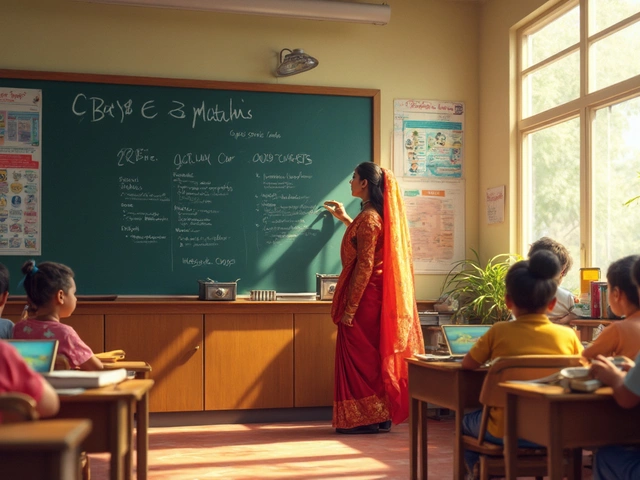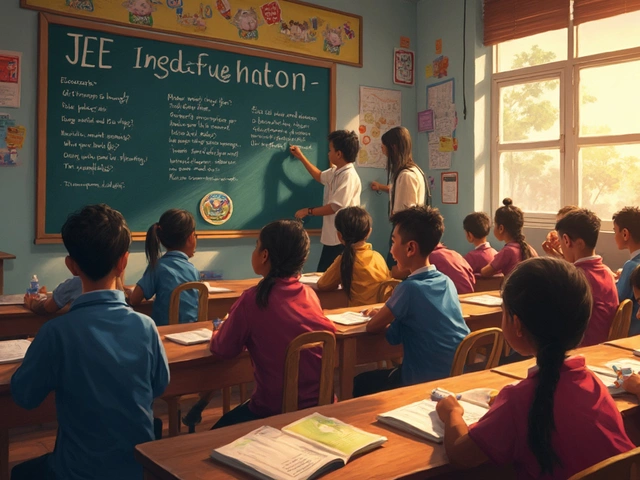Apr
16

- by Dhruv Ainsley
- 0 Comments
So, you're scratching your head over whether to go with the British curriculum or CBSE for your child. It's a pretty big decision, huh? These two systems are like apples and oranges, each with its own flavor.
Let's start with the basics. The British curriculum is quite the worldly traveler, often adopted by international schools. It's known for promoting critical thinking and independence. The CBSE, on the other hand, has a strong hold in India, focusing on a more structured learning approach that's packed with rigorous science and math.
But here’s the biggie: What matters most to you and your child? Is it global exposure and creative thinking, or is it a solid academic foundation that could cushion future studies? That's the real question.
- Understanding the Basics
- Teaching Methods and Style
- Global Recognition and Opportunities
- Flexibility and Innovation
- Assessment and Grading
- Making the Right Choice for Your Child
Understanding the Basics
Diving into the educational sea of choices can be a bit overwhelming, especially when picking between the British curriculum and the CBSE syllabus. These two are like foreign languages, each speaking to different educational needs and goals.
First up, the British curriculum, often referred to as the National Curriculum for England, is famous for its global reach. You'll find it in international schools around the world. It generally runs from Key Stages 1 to 5, covering everything from basic primary education all the way up to A-levels, which are a big deal when it comes to university entries.
The CBSE curriculum, short for the Central Board of Secondary Education, primarily serves students in India but is also found in a few schools abroad. CBSE is known for its structured approach, with a clear focus on science and math subjects. It's standardized across all affiliated schools, which makes transferring between schools easier. The system includes two main exams: the All India Secondary School Examination (AISSE) for Grade 10 and the All India Senior School Certificate Examination (AISSCE) for Grade 12.
Though both systems aim for excellence, they walk slightly different paths. The British curriculum encourages a more outward-looking approach, facilitating not just academic proficiency but also personal growth through extracurricular activities. CBSE, however, is more about providing a uniform and consistent educational experience irrespective of where you study.
Here's a quick comparison of how they stack up:
| Aspect | British Curriculum | CBSE Curriculum |
|---|---|---|
| Global Presence | High, especially in international schools | Mostly within India |
| Core Focus | All-rounded, with emphasis on creative thinking | Strong in math and science |
| Standardization | Less uniform, flexibility in subjects | Highly standardized across affiliated schools |
Understanding these basics can give you a clearer picture of what each curriculum stands for. The choice boils down to what's more important for your child and your family's educational goals.
Teaching Methods and Style
When it comes to teaching methods, the British curriculum and the CBSE syllabus have their own distinct flavors. Picture the British system as a more laid-back surfer who's really into equipping kids with skills they’ll need globally. They focus on critical thinking, problem-solving, and giving students a chance to explore subjects with a fair amount of freedom. This means fewer textbook-based lectures and more project work and research.
On the flip side, CBSE schools tend to be more like drill sergeants with a plan. This system emphasizes core subjects like math and science, with a well-defined syllabus that ensures students get a deep understanding. More traditional in approach, the teaching here is structured with regular teacher-led instructions, and there's a bigger focus on exams to gauge student performance.
The British system often uses cross-disciplinary activities, helping students see connections between subjects. For instance, a history lesson may spill over into a geography discussion. Creativity and individuality are valued, letting students shine in their unique way.
CBSE promotes uniformity and ensures that students across India cover the same topics at the same time. This can be a bonus for families who move frequently within India, as students can easily adjust without missing out on core components. The NCERT books used in CBSE are comprehensive and provide a clear path for exam preparation.
Whether you lean towards the British creative approach or the systematic CBSE method might boil down to how structured or liberal you want the learning process to be. Each has its pros and cons, so the call depends on what suits your child's learning style the best.
Global Recognition and Opportunities
When it comes to global recognition, the British curriculum often gets a thumbs up from international universities. It’s like the golden ticket to studying abroad, especially in places like the UK, the US, and Australia. That’s because it aligns well with their higher education systems.
The A-Level qualifications are respected worldwide, opening doors to a variety of undergraduate programs. It's also great if you're moving around a lot, as British schools are scattered globally, making transitions smoother for students.
On the other hand, the CBSE syllabus is strong domestically and is gaining traction internationally, especially in the Middle East and other countries with a large Indian population. While CBSE graduates may need additional tests for some international universities, their strong foundation in math and science can be an advantage.
Here's a fun fact: A study revealed that CBSE students often excel in international math and science competitions, thanks to their rigorous training. But if your kid plans on settling abroad later, aligning with the British system might be worth considering for that extra edge.
Whether it’s about getting into a top-tier college or even snagging a scholarship, knowing the recognition and opportunities each curriculum offers can save you a lot of trouble down the road.

Flexibility and Innovation
When it comes to flexibility and innovation, the British curriculum shines in a way that might surprise you. It’s like having a toolbox full of creative resources at your disposal. This system is designed to adapt to new teaching methods and integrates technology into classrooms, encouraging schools to tailor learning experiences to student needs.
The British curriculum is known for its open-ended approach, which allows students to explore subjects in-depth through project-based learning. This kind of learning is not just about textbooks; it’s about applying knowledge to real-life scenarios. Subjects like design and technology often involve hands-on projects that help students learn by doing, fostering a sense of innovation and creativity.
On the flip side, while the CBSE syllabus is more prescriptive, it doesn’t mean it's lagging. Recently, CBSE has been revamping its approach, incorporating more digital tools in classrooms and allowing slight wiggle room for creativity through its emphasis on honing analytical skills. CBSE is gradually integrating more practical applications in subjects, especially in science and math, pushing students to move beyond traditional rote learning.
Many schools under the CBSE umbrella have started bringing in additional programs and co-curricular activities to break the monotony of bookish learning. Robotics clubs, coding classes, and science exhibitions are some of the initiatives that nurture innovative thinking, giving students a chance to stretch the boundaries of conventional learning.
In a nutshell, both British and CBSE curriculums are adjusting to the needs of the modern educational landscape by embedding flexibility and encouraging students to think outside the box. Whether you value the experimental edge of the British system or appreciate the structured yet evolving nature of CBSE, the key is to align with what sparks joy and curiosity in your child’s learning journey.
Assessment and Grading
Alright, let's dive into how these two systems, the British curriculum and the CBSE syllabus, handle assessments and grades. Because understanding this can make a world of difference in how your child experiences school.
Starting with the British curriculum, assessments are pretty diverse. You'll find coursework, oral presentations, and those dreaded exams, but they also sometimes include projects and group work. It’s all about seeing how students apply what they’ve learned in real-world contexts. We can say it’s more continuous and less about that one big test at the end.
Meanwhile, the CBSE is more exam-heavy, focusing on end-of-term tests. CBSE exams tend to emphasize core subjects like math and science, with grades often based on final exam-only schemes. It's intense, but it helps polish those mugging-up skills, a right passage for some.
Both systems bring their own stress levels. With the British way, there's ongoing pressure to deliver consistently. With CBSE, it’s intense bursts of study for those major exams.
To give you an idea of grading, check this out:
| Curriculum | Assessment Style | Grading System |
|---|---|---|
| British | Coursework, exams, projects | Letter grades (A* to U) |
| CBSE | Exams | GPAs or percentage |
The British curriculum typically uses letter grades from A* to U, where A* is top-notch. CBSE, often uses a percentage or Cumulative Grade Point Average (CGPA), where a 10 is the dream score.
So, choosing between them isn't just about the grades on the paper but the learning experience your child will have. Think about their learning style, what stresses them out or excites them. That's how you'll figure out which assessment style fits them best.
Making the Right Choice for Your Child
Alright, let's get into the nitty-gritty of making the best pick for your kiddo's education. Deciding between the British curriculum and CBSE isn't just about comparing subjects—it's about thinking long-term and what's best for your child.
First off, consider your child’s learning style. If they thrive in an environment that encourages creativity and independent thought, the British curriculum might be up their alley. It's known for emphasizing critical thinking skills. But if your child is more at ease with a structured approach that's heavy on science and math, CBSE has its own perks, providing a robust environment for these subjects.
"The best education isn't about the system, but how your child fits within it." — Anonymous Educator
Second, think about future opportunities. If you're planning for higher studies abroad, especially in the UK or other Commonwealth countries, a British curriculum is globally recognized. But if staying in India or pursuing fields that align with Indian entrance exams is the goal, CBSE is widely accepted and even preferred.
Let's also talk about assessment. The British system often uses ongoing assessments and coursework which some students find stress-free compared to the more exam-focused CBSE approach. Understanding how your child handles stress can be a deciding factor here.
- Ask your child what they enjoy learning about most.
- Consider where you see your child in the next 5-10 years.
- Look into school performance and teaching styles.
No need for a crystal ball here, just a little thought and a chat with your child could clear up the fog.
In the end, it's about matching the school’s strengths to your child’s needs. Whether you go British or CBSE, it'll be your thoughtful decisions that guide the way.





